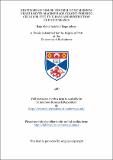Files in this item
Responses of mouse femoral bone marrow granulocyte-macrophage colony-forming cells (CM-CFC) to X-rays and restriction endonucleases
Item metadata
| dc.contributor.advisor | Riches, Andrew Clive | |
| dc.contributor.author | Adnan, Raja Abdul Aziz bin Raja | |
| dc.coverage.spatial | 125 p. | en_US |
| dc.date.accessioned | 2018-06-11T13:10:16Z | |
| dc.date.available | 2018-06-11T13:10:16Z | |
| dc.date.issued | 1987 | |
| dc.identifier.uri | https://hdl.handle.net/10023/13904 | |
| dc.description.abstract | The effect of X-rays on mouse normal femoral bone marrow GM-CFC was compared using two different in vitro cell culture techniques - the agar colony assay and the radioisotope uptake assay (125IUdR or 3HTdR). The values obtained with the agar colony assay was 1.00 +/- 0.09 Gy and 2.10 +/- 0.10 Gy as measured by the radioisotope assay. Similar values were observed when the bone marrow cells were irradiated to vitro or to vivo. It was observed that the concentration of WEHI-3B conditioned medium (CSA) used in the agar colony assay would affect GM-CFC content of irradiated or normal bone marrow cells. But when optimum or greater levels of CSA were used the survival parameters plateaus. Pre-trypsinisation of bone marrow cells was not demonstrated to have modified the radiation survival characteristics of GM-CFC to X-rays and Do were not significantly different from GM-CFC from untreated bone marrow cells. Two distinct subpopulations of GM-CPC were observed based on their sensitivity to trypsin. One was survival-dose dependent and the other totally unaffected by increasing trypsin concentrations. Their ratio was approximately 1:1. Trypsin permeabilised murine bone marrow cells were treated with restriction endonucleases Pvu II and Bam HI. It was postulated that these endonucleases generated blunt-ended and cohesive-erided double-strand breaks (dsb), respectively. The cells were then assayed for their clonogenic ability to simulate GM-CFC death following X-ray exposure and to test the hypothesis that cell death arises from the induction of dsb in DNA via the formation of chromosomal aberrations. The results reported here show that Pvu II simulates X-ray exposure in causing a dose-dependent loss of the reproductive integrity of mouse femoral bone narrow GM-CPC, whilst Bam HI was found not to reduce cell survival even when concentrations greater than Pvu II were employed. These results support the idea that X-irradiated mammalian cells undergo a mode of death in which dsb in the DNA are lethal resulting in the loss of clonogenic ability. In contrast to previous experiments using inactivated Sendai virus, 0.001% trypsin was used to permeabilise the cells before treatment with the restriction endonucleases. However, when 0.05% trypsin was used Pvu II was shown not to further reduce the survival fraction of GM-CFC. The storage buffer containing the restriction endonucleases were found to be toxic but a region of tolerance was observed when the lower trypsin concentration was used. This had enabled the study of the effect of the restriction endonucleases on GM-CFC without the complicating presence of other forms of damage. From the D37 values, a dose of 142 +/- 4 units of Pvu II was equivalent to 1.20 Gy of X-rays (ie. 100 units = 0.85 Gy). | en_US |
| dc.language.iso | en | en_US |
| dc.publisher | University of St Andrews | |
| dc.subject.lcc | QH465.A3 | en |
| dc.title | Responses of mouse femoral bone marrow granulocyte-macrophage colony-forming cells (CM-CFC) to X-rays and restriction endonucleases | en_US |
| dc.type | Thesis | en_US |
| dc.contributor.sponsor | Malaysia Department of Public Service | en_US |
| dc.contributor.sponsor | Malaysia Nuclear Energy Unit | en_US |
| dc.type.qualificationlevel | Doctoral | en_US |
| dc.type.qualificationname | PhD Doctor of Philosophy | en_US |
| dc.publisher.institution | The University of St Andrews | en_US |
This item appears in the following Collection(s)
Items in the St Andrews Research Repository are protected by copyright, with all rights reserved, unless otherwise indicated.

